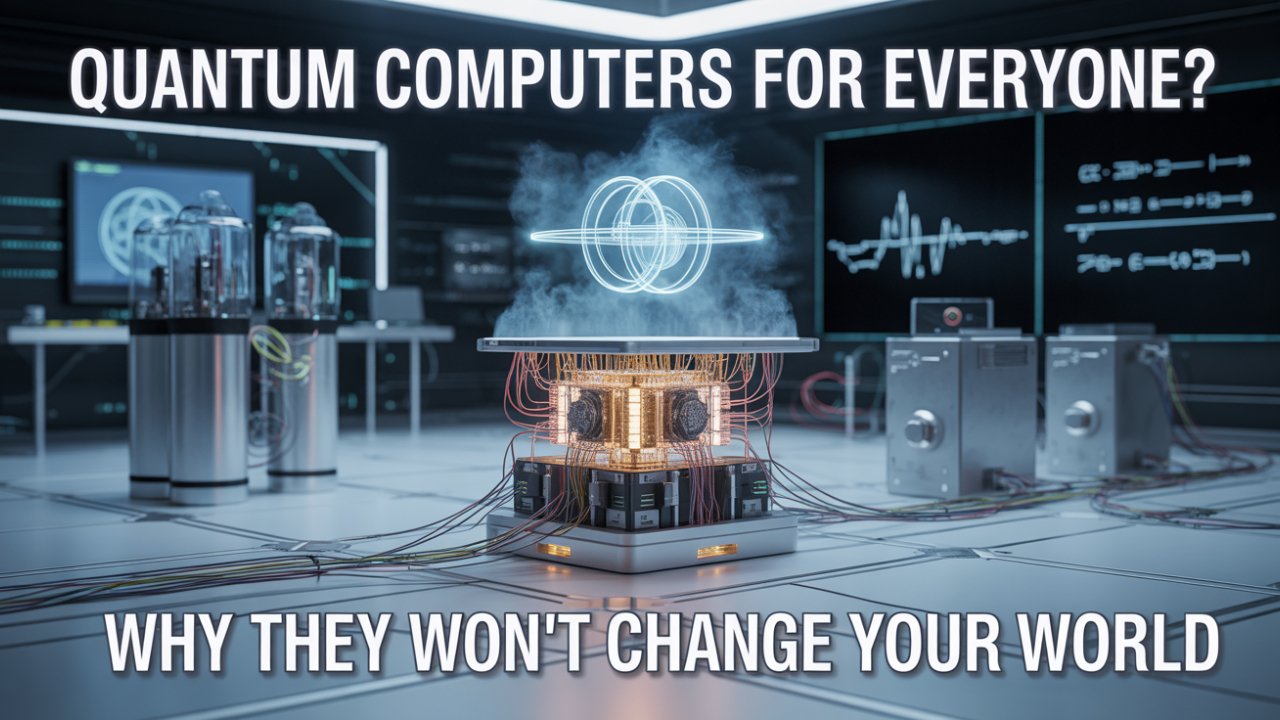We’ve all heard the hype. We’ve seen the headlines. A new era of computing that’s going to change everything. Computers powerful enough to solve humanity’s greatest problems from curing diseases to unlocking the secrets of the cosmos. A quantum future, just around the corner.
But that future? It isn’t for you.
In fact, I’m going to explain why this so-called revolution will never actually reach your home, and why that’s not a bad thing at all. For decades, we’ve been sold a sci-fi story about quantum computers being the next step for all of us, a machine that will replace your laptop or smartphone. But that’s a huge misunderstanding of what these machines are and what they’re built for.
Today, we’re separating the quantum hype from the quantum reality. We’re going to dismantle the dream of a quantum-powered PC, piece by piece, and then rebuild our understanding to see where this technology will truly make its mark. And I promise, the answer is way more interesting and far more important than just a faster way to check your email.
The story always starts with a sense of awe. We’re told that our everyday classical computers are hitting a wall. Moore’s Law the rule that processor power doubles every two years is finally slowing down. We can only shrink transistors so much before we smash right into the weird, unpredictable laws of quantum mechanics. So, the story goes, the only path forward is to embrace the weirdness and build a computer that plays by the universe’s most fundamental rules.
And the promises that come with this story are just staggering. The hype says quantum computers will trigger breakthroughs in every field you can imagine. They’ll discover new wonder drugs overnight by simulating molecules with perfect accuracy. They’ll help solve climate change by designing new catalysts that can literally suck carbon out of the air. They’ll create artificial intelligence that’s genuinely conscious. And of course, the most famous promise of all: they’ll break every form of modern encryption, leaving all our digital secrets totally exposed.
It’s a powerful story. It captures our imagination, this idea of a quantum leap into a new age. The media loves it, using phrases that make it all sound so close. Analysts have compared the coming quantum revolution to the discovery of fire, a technology that will reset everything. When you hear that a quantum computer solved a problem in minutes that would take a supercomputer septillions of years, it’s easy to imagine that power eventually ending up in our hands.
To get the hype, you have to get the source of the power: the qubit. Your computer uses bits, which are just tiny switches that are either a 0 or a 1. Simple, reliable, on or off. A quantum bit, or qubit, is different. Thanks to a quantum property called superposition, a qubit can be a 0, a 1, or both at the same time, existing in a haze of probability. Think of it like a spinning coin. Before it lands, it’s not heads or tails it’s in a state of both.
And it gets weirder. Thanks to another property, entanglement, you can link two qubits so their fates are intertwined. No matter how far apart they are, if you measure one and it lands heads, you instantly know the other is tails. Einstein famously called this spooky action at a distance.
Combine these two things, and you get a machine that can explore a mind-boggling number of possibilities all at once. While a regular computer has to check every path in a maze one by one, a quantum computer can, in a way, check them all simultaneously. This is where that exponential power comes from. Two qubits explore four states. Three qubits explore eight. Three hundred qubits could explore more states than there are atoms in the known universe.
This is the quantum dream. A computer that harnesses the almost magical rules of the subatomic world to solve problems we can barely wrap our heads around. The natural conclusion for many people is that this power will eventually be shrunk down, packaged, and sold as the next PC. But this is where the dream smashes into a wall of cold, hard reality. And that reality starts with a simple truth: for almost everything you do, a quantum computer is completely useless.
Let’s start with the biggest misconception of all. Quantum computers are not just faster versions of what we have now. They’re a totally different kind of tool, built for a totally different set of problems. Using a quantum computer to write an email would be like using a multi-billion-dollar particle accelerator to make toast. It’s not just overkill; it’s the wrong tool for the job.
Our classical computers are deterministic. You type the letter ‘A’, you get the letter ‘A’. Every time. They follow strict, logical instructions to give a predictable, correct answer. Quantum computers, on the other hand, are probabilistic. They don’t give you one clean answer. They give you a probability distribution a range of possible answers, where one is likely the right one. You often have to run the same calculation over and over and take the most common result just to be sure. For the things we do every day sending emails, streaming videos, playing games that is just ridiculous. Your laptop is already fantastic at those things. A quantum computer gives you zero advantage.
But even if you had a problem that was perfect for a quantum computer, you still wouldn’t have one in your home. That’s because the very quantum weirdness that gives these machines their power also makes them impossibly fragile. The spinning coin idea is a good start, but a better analogy would be trying to build a beautiful, intricate sandcastle during a hurricane.
The main villain in the quantum story is a thing called decoherence. A qubit’s delicate superposition state is incredibly unstable. The absolute slightest disturbance from the outside world a tiny vibration, a stray magnetic field, a tiny shift in temperature can cause it to collapse, or decohere, into a boring old classical bit, either a 0 or a 1. That collapse destroys the entire calculation.
So how do scientists fight this hurricane of noise? With some of the most extreme engineering on Earth. Most of today’s top quantum computers from places like Google and IBM use superconducting qubits. These are tiny circuits that, when cooled to absurdly low temperatures, let electricity flow with zero resistance. And when I say absurdly low, I mean colder than deep space.
These quantum chips live inside massive, multi-million-dollar machines called dilution refrigerators. They are basically the most advanced thermoses ever built, with layers of gold-plated shielding and complex plumbing that use helium isotopes to pull heat away from the chip, step by step. Down at the core, where the quantum processor sits, the temperature is about 15 millikelvin. That’s about -273.135 Celsius, just a hair above absolute zero, the coldest temperature possible in the universe. You don’t need a cooling fan for your quantum computer; you need a dedicated power plant just to run the fridge that keeps it from instantly becoming a useless piece of metal. So, unless you plan on installing a two-ton, cryogenic chandelier in your living room, you’re not getting one at home.
Other types of quantum computers, like those using trapped ions, have their own crazy requirements. They use powerful magnetic fields to hold individual atoms in a vacuum chamber that’s emptier than interstellar space. Then they blast those atoms with precisely aimed lasers to nudge them into superposition. Again, not exactly desktop-friendly stuff.
So, quantum computers are picky. They only solve very specific problems, and they have to be kept in the coldest, quietest, most isolated places imaginable. But even if you manage all that, you hit the next giant hurdle: they make mistakes. All the time.
When you see headlines about quantum computing, the number that always gets thrown around is the qubit count. IBM has a chip with over 1,000 qubits. Roadmaps point to systems with over 4,000 by 2025. This sounds a lot like the megahertz race for PCs back in the 90s. But this is probably the single most misleading metric in tech today. The number of qubits is almost meaningless if you don’t understand the difference between a physical qubit and a logical qubit.
The qubits I just described are all physical qubits. And as we’ve established, they are incredibly error-prone. Decoherence means they’re constantly making mistakes. Noise corrupts the calculation, and the final answer is junk. A classical computer might have one error in a quadrillion operations. Today’s quantum computers can have an error in one out of every thousand operations. That’s a catastrophe. You can’t run anything meaningful on a machine that unreliable.
The solution is something called quantum error correction. And this is where the hype about big qubit numbers just falls apart. To protect one single piece of quantum information, you have to encode it across many, many physical qubits. Most of these qubits aren’t doing the calculation; they’re just acting as watchdogs, constantly checking their neighbors for errors and voting on what the correct state should be. This bundle of physical qubits, all working together to create one stable, reliable qubit, is called a logical qubit.
That is the number that actually matters. How many stable, error-corrected logical qubits does a machine have? And the ratio is mind-blowing. Current theories suggest you might need anywhere from 1,000 to maybe 10,000 of today’s noisy physical qubits to create a single, high-quality logical qubit.
Let that sink in. A company could announce a one-million-qubit computer, and it would sound amazing. But if it takes 1,000 of their physical qubits to make one logical one, what they really have is a 1,000 logical qubit machine. And to do something truly world-changing, like breaking today’s encryption, estimates suggest you’d need a machine with at least tens of thousands, and maybe millions, of stable logical qubits. We are nowhere close to that. We are just now proving that the basic idea of error correction even works.
And that’s before you get to the nightmare of scaling. In a classical chip, you just add more transistors. In a quantum computer, every new qubit has to be able to talk to its neighbors through entanglement. As you add more qubits, the complexity of controlling them all, keeping them isolated from the world but perfectly connected to each other, grows exponentially. It’s like conducting an orchestra where every musician has to hear every other musician perfectly, but they’re all in separate soundproof rooms, and a single cough from the audience can ruin the whole show.
This isn’t just an engineering problem; it’s a fundamental physics problem.
Okay, I’ve painted a pretty grim picture. They’re expensive, fragile, error-prone, and a nightmare to scale. So why are governments and tech giants pouring billions of dollars into them? Is it all just hype?
No. Because for a very specific and very important set of problems, they are set to be truly revolutionary. We just have to stop thinking of them as personal computers and start seeing them as the ultimate scientific instruments. They aren’t meant to replace your laptop; they are a new class of supercomputer, accessed through the cloud by scientists to solve problems that are literally impossible for any classical machine. There are three main areas where they shine.
First, and maybe the most important, is simulation. Specifically, simulating other quantum systems. The physicist Richard Feynman famously said, Nature isn’t classical, dammit, and if you want to make a simulation of nature, you’d better make it quantum mechanical. He meant that the world around us molecules, chemical reactions, new materials is governed by quantum mechanics. Trying to simulate that on a classical computer is like trying to describe a color to someone who can only see in black and white. You can get close, but you’ll always miss something.
A quantum computer, being a quantum system itself, can build a simulation of a molecule that is far more true to life than any classical machine ever could. This could revolutionize medicine and materials science. Instead of years of trial-and-error in a lab, researchers could test thousands of potential drug candidates in a high-fidelity simulation, finding the best ones in a fraction of the time. This could speed up the discovery of new drugs for diseases like Alzheimer’s or cancer. Engineers could design new materials atom by atom for a hyper-efficient solar panel, a catalyst to create clean fertilizer, or an EV battery that could go a thousand miles on a single charge.
The second area is complex optimization. Think of any problem with a staggering number of variables where you need to find the single best solution. The classic example is the traveling salesman problem. Given a list of cities, what’s the shortest route to visit each one? With a few cities, it’s easy. With thousands of delivery trucks in a global shipping network, the number of possible routes is astronomical. Quantum computers could explore these vast possibility spaces to find the optimal solution, saving huge amounts of fuel and time.
The third area is the one that gets all the press: cryptography. A mathematician named Peter Shor developed an algorithm that could, on a powerful quantum computer, factor large numbers with terrifying speed. This is a big deal because most of our internet security relies on the fact that this is incredibly hard for normal computers to do. A large-enough, error-corrected quantum computer running Shor’s algorithm could break this security.
This is a real threat, but it needs perspective. The kind of machine needed for this is likely decades away. And more importantly, the cybersecurity world is already on it. A whole field called post-quantum cryptography is developing new encryption that’s safe from both classical and quantum attacks. This change will happen behind the scenes. Your browser and apps will update, and you probably won’t notice a thing.
So, if a quantum computer will never sit on your desk, does that mean it’s irrelevant to you? Not at all. The quantum revolution is happening, but it’s an indirect one. You will almost certainly never own a quantum computer, but you will own products and use services that were designed with one.
Think of it this way: you don’t have a giant wind tunnel in your garage, but the car you drive is more fuel-efficient because its shape was tested in one. Quantum computers will be the same. They will be massive, centralized, industrial tools used by a few key industries to make breakthroughs.
The most profound impact will probably be in healthcare. A new drug for Parkinson’s or a personalized cancer therapy might be developed because a quantum computer could model molecular interactions in a way we never could before. You won’t see the computer, but you’ll get the medicine it helped create.
The fight against climate change could see huge benefits. A breakthrough in battery technology, made possible by quantum simulation, could make electric cars cheaper and better. A new process for making fertilizer could drastically cut the carbon footprint of global agriculture.
Your packages might arrive a day faster because a quantum computer optimized the entire delivery network. The economy could become more stable because quantum models helped predict market volatility. This is the real quantum future. It’s not a world where we all have magic boxes in our homes. It’s a world where these incredible machines are working in the background, tackling grand challenges that are currently out of our reach.
So while a quantum computer won’t be replacing your gaming PC, the science behind it is one of the most thrilling fields out there. What do you think is the most realistic application we’ll see first? A new drug, a new battery, or something else entirely? Let me know your thoughts in the comments. And if you enjoy cutting through the hype to get to the real science, maybe subscribe so you don’t miss our next breakdown.
The story of quantum computing is a perfect example of how technology really works. It’s almost never a straight line, and powerful tech doesn’t always end up where we first expect. The first cars were just horseless carriages, a simple replacement for what came before. No one saw that they would lead to suburbs, superhighways, and a complete reshaping of the world.
We’ve been stuck on the idea of the quantum computer as a faster laptop. But its real destiny is something far grander and more specialized. It’s not the next personal computer. It’s a new kind of scientific instrument, maybe the most powerful one we’ve ever dreamed up. Like the Hubble Telescope or the Large Hadron Collider, it’s a machine built not for everyone, but for a few experts to peer deeper into the workings of the universe.
The quantum revolution is coming, but it won’t be happening on a screen in your living room. It’s happening quietly, in the coldest, most silent places on Earth, where scientists are carefully coaxing atoms into solving the problems that will define our future. And that’s exactly where it needs to be to change the world.





